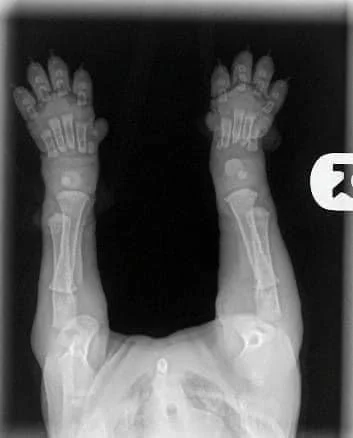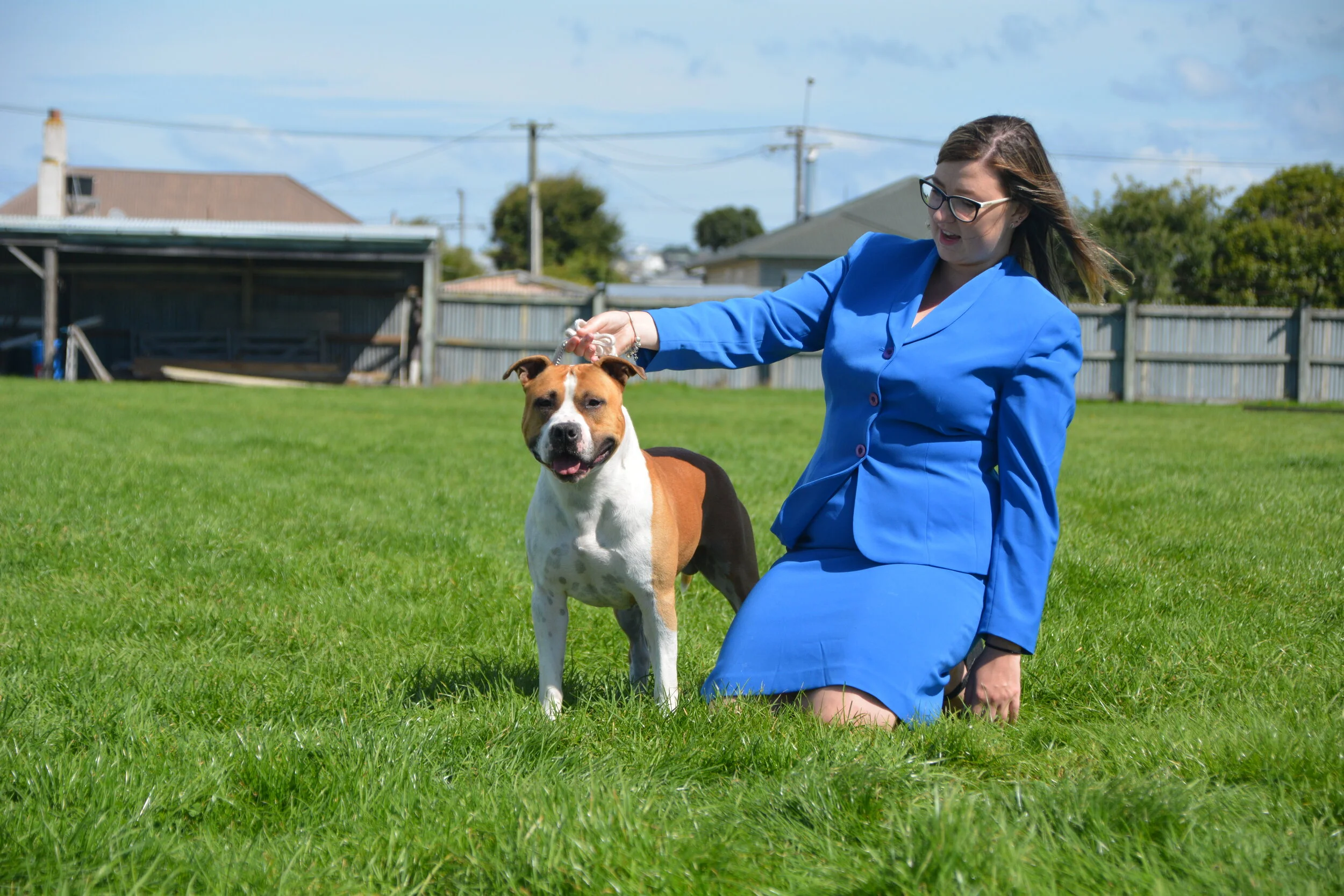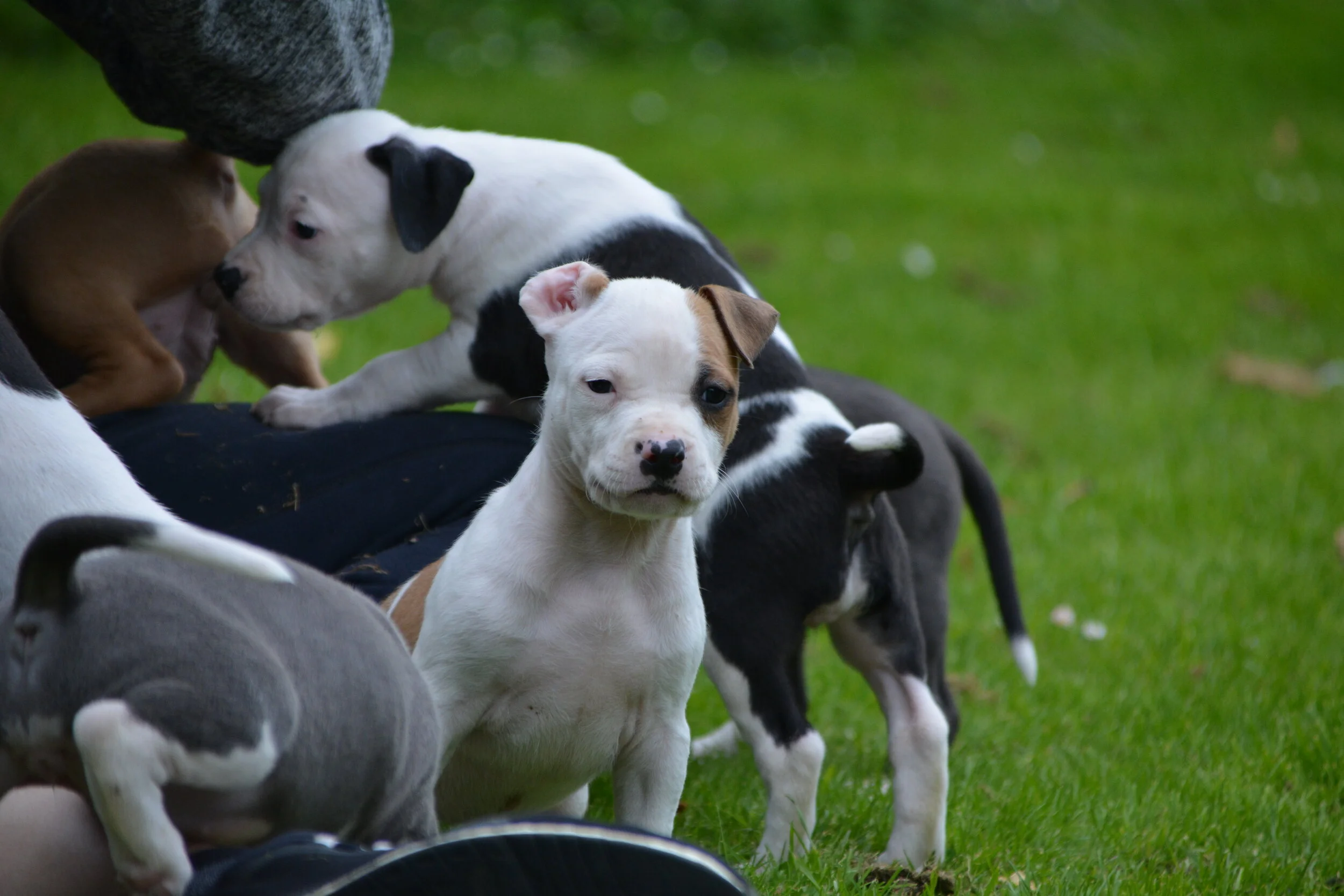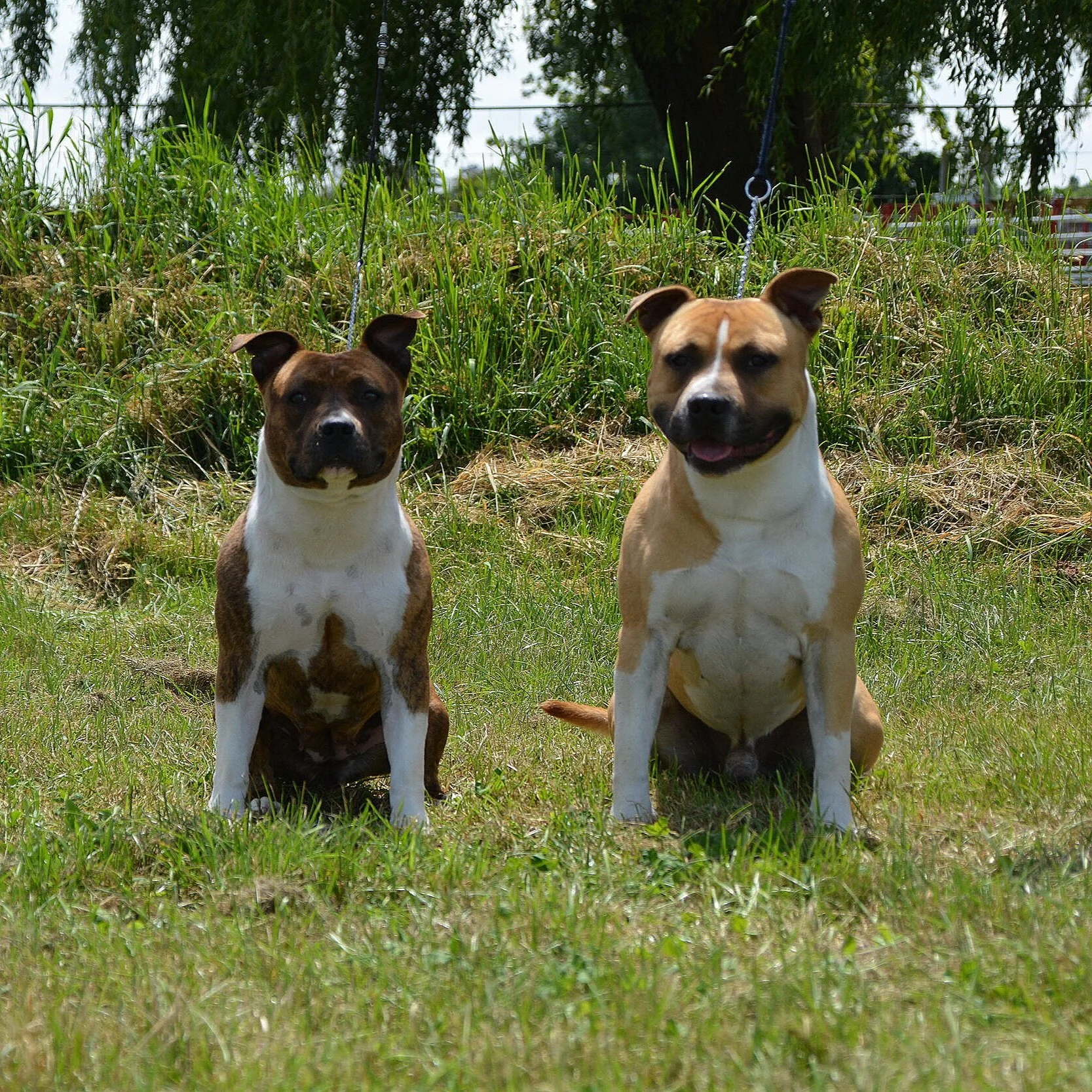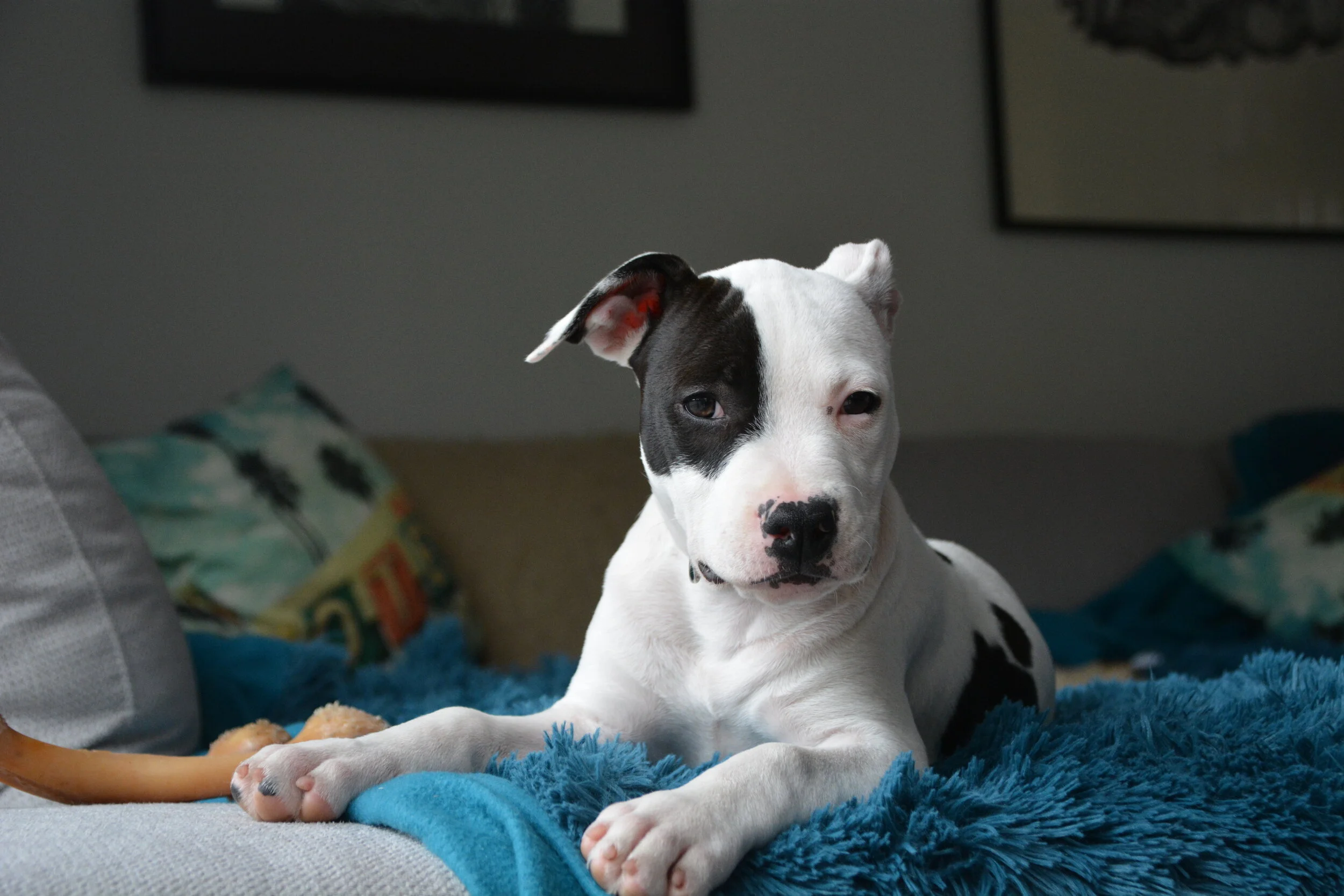Origins of the American Staffordshire Terrier
Ancient Ancestry of the Amstaff
The ancient ancestors of the Amstaff are the mastiff type dogs who appear in many breed histories. Although much of this information is lost in antiquity, we know from early art of the large, heavy-headed strong dogs who were used throughout history for their strength and guarding abilities. This early group of dogs has left genetic material for all the bulldog breeds and mastiff type dogs of today.
In earlier days in England, mastiff types were bred down to smaller size and some became bulldogs (actually bulldogs were named because they were used to hold on to bulls or cattle/oxen).
Originally the dogs were butchers dogs or farmers dogs who helped move the cattle around and held them still fore their owners. They kept them still literally by holding on to them, usually by the nose. It became a customary entertainment in England to watch as the butcher's dog caught the bull and held in while it was killed by the butcher.
For some reason the common folk began to think that meat that had been harried by the dog before dying was tastier than the meat the had died peacefully. There was for a time an English law enacted that the butcher MUST bait the bull with a dog before butchering it.
The entertainment value was so great, that the Queen reportedly even forbid other butchers from killing their stock on the same day her royal butcher did, so that the commoners would watch her dogs work.
Terriers
Eventually this sport gave way to some other type of meat tenderizer and the dogs were used on other "game". One of these uses was rat killing. The English seem to have had lots of rats and folks amused themselves by watching dogs put into "pits" (arenas) with hundreds of rats.
Of course betting was done on how many could be dispatched how fast. This called for a smaller, faster dog so some of the now extinct English terriers were crossed with the bulldog.
These were probably Black and Tan terriers (similar to today' Manchester) and the old White terrier. Rats were too easy, so these sporting souls were always thinking up new challenges for their dogs. These early bulldogs and now bull-and-terriers were used to fight bears, stage, badgers, and each other.
Dogs were more easily come by than bears, which were probably getting kind of scarce in England, and dogs were probably easier to keep for a commoner than expensive cattle.
The bull-and-terriers evolved into three of our modern breeds: the Staffordshire Bull Terrier, the Bull Terrier, and the American Staffordshire Terrier.
American Bull-and-Terrier Evolution
The early bull-and-terrier came to America with immigrants from England and Ireland. Here some grew bigger and taller in response to their duties in a new and wilder country. Some stayed in cities and were kept by the same type of "sporting" owner as in England and Ireland. These were fought against each other around the pubs of New York, Chicago, and Boston (and other cities of course).
A product of some of these dogs is the very American breed of Boston Bulldog, or Boston terrier as it is now known. These used to be 35-40 lb dogs, and except for the shorter bulldog face and screw tail were very similar to the early American Staffordshire Terrier (or Pit Bull, Bulldog, American Bulldog, Bull and Terrier, Yankee Terrier).
The larger bull-and-terrier was still a farm dog and stockman's dog. He followed the wagons west with the settlers and helped work stock and guarded the homestead. He was a general purpose homestead dog, much as the dog describe in the book and movie, Old Yeller.
He ran with the hounds on hunting expeditions, exactly as depicted in the old movie, The Yearling, and although not as fleet or strong of nose as the hounds, he was still the "catch" dog who dispatched the animal when it turned at bay.
By the late 1800's a fighting dog registry was started in America to keep track of the prized pedigrees and publish the rules for fighting organization in the country. The United Kennel Club registered the dogs as American Pit Bull Terriers. Sometimes this was written as American (pit) Bull, or American Bull Terrier. Mostly they were known as bulldogs, or Pit Bulls.
Although it is this dog fighting background that is mostly remembered, only a relatively small number of the dogs were fought.
Most of them went on being farmer's and general purpose countrymen's dogs, and still worked stock, penning and guarding and helping, just as they had done in their earliest days.
American Staffordshire Terrier Registration with the American Kennel Club
In the early 1930's a group of fanciers petitioned the American Kennel Club to accept their dogs into the registry. These dogs already registered with the United Kennel Club, but their owners had no interest in dog fighting.
They wanted to promote their breed as family dogs and show dogs. They formed a national breed club and wrote a standard for the breed.
Much agonizing was done over the proper name for the breed, and the American Kennel Club was not inclined to register them with the same name as the United Kennel Club did.
Finally they were accepted with the name of Staffordshire Terrier in 1936.
This was just a year after the English bull-and-terriers under the same name of the Staffordshire Bull Terriers were recognized with the Kennel Club of England.
The standards of both the English and American breeds were written similarly, and even contained some identical phrases. The authors of both kept in touch with each other, working toward their common goad of acceptance by their kennel clubs. At that time, the dogs described were more similar in size and structure than the breeds appear today.
In the early 1970's the name of the Staffordshire terrier was changed to American Staffordshire terrier, when the American Kennel Club recognized the Staffordshire Bull Terrier breed.
Even as the late as the 1960's, the AKC stud books were opened to permit United Kennel Club registered American Pit Bull Terrier to compete in AKC shows as American Staffordshire Terriers. Some exceptional dogs were brought into the AKC registry at the time, some even winning the Staffordshire Terrier Club of America National Speciality and an all-breed best in Show.
Their influence is still strong in some breeder's lines today.
The American Staffordshire Terrier has an amazing identity problem. The same dog can still be registered the United Kennel Club (which is no longer a fighting dogs registry, but an all breed registry similar to the American Kennel Club), and/or with the American Dog Breeders Association, as an American Pit Bull Terrier. And, if its parents were registered with the AKC, it can also be registered by the AKC under the name of the American Staffordshire Terrier.
Some of the breeders of both American Staffordshire Terriers and American Pit Bull Terriers will tell you that they are not the same breed and the "the other registry group" is ruining the breed. However, the only real difference between these dogs is their name and registry, and the individual breeder's selections and goals.
There was no other breed of dog added to the bloodlines to create American Staffordshire Terriers.
This breed, under several of its names, along with the Staffordshire Bull Terrier has been under attack by anti-dog groups and has been wrongly maligned by the media. The generic name of "pit bull" has now become a term to denote a dog used for fighting, no matter what its genetic background, much like saying "bird dog" or "guard dog". Most of the dogs now called that, we would all call mixed breeds.
However, there is still a Breed of dog called American Pit Bull Terrier, and many of them trace their pedigrees back to the 1800's. Many of them are still exactly where they have always been, working at their jobs and being faithful companions.
This article was written by the S.T.C.A







